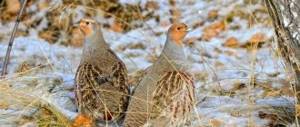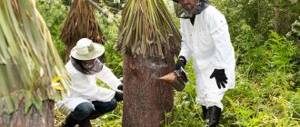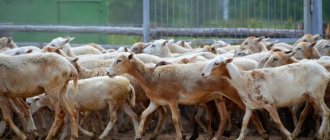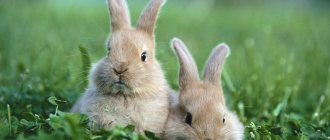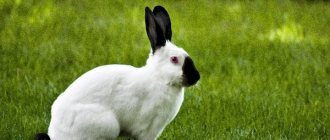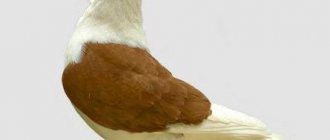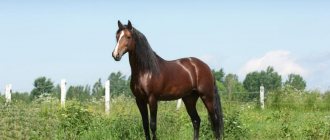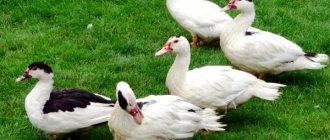Description and features
The musk ox in the photo appears as a shaggy animal of medium or large size. The limits within which the size and weight of adults vary are significant. They depend on the sex and habitat of a given herd. The weight of mature males reaches 350 kg, the height from the ground to the withers is about 150 cm. The females are half the weight and 30% less in height.
Western Greenland is home to the largest wild musk oxen. In the north - the smallest. Everything depends on the availability of food. In captivity, where minimal effort is required to obtain food, males can gain more than 650 kg of weight, and females can reach up to 300 kg. The differences between females and males are expressed primarily in the size of the animals.
Like the Tibetan yak , the musk ox is covered down to the ground with a woolen, shaggy coat. Which makes him seem like a stocky, muscular animal. The feeling of strength is added by the scruff of the neck and the large, low-set head. Together with the horns, the head acts as the main striking weapon.
Both males and females have horns. For males, they serve not only as protection from external enemies, but also as a weapon during mating tournaments. For this reason, the horns of males are noticeably larger. They reach their maximum size by 6 years of age. Probably, this age can be considered the heyday of the male musk ox.
The horns of musk oxen are somewhat similar in shape to the horns of African buffalos. The bases are thickened, shifted towards each other and pressed against the skull. Females do not have a thickened base; on the frontal part between the horns there is a patch of skin covered with white hair.
The middle parts of the horns fit around the head like hanging ears, then rise to the top. The points of the horns look up, to the sides and slightly forward. Musk oxen in Taimyr have horns up to 80 cm long. The span is within 60 cm. The diameter of the base can be 14 cm.
The musk ox's skull is massive. The forehead and the post-corneal surface lie in the same plane. The shape of the skull resembles a rectangular box up to 50 cm long and up to 25 cm wide. The nasal bones are elongated by 15-16 cm. The upper row of teeth is about 15 cm wide. The anatomy of the head, including the jaws and teeth, is similar to that of a bull. The rest of the body is more like a goat's.
The musk ox is colored quite varied. The fur on the head and lower part of the body is colored black and brown. The rest of the body may be brown, black, or smoky. The albino musk ox is extremely rare. A white musk ox in regions where there is snow 70% of the time would look quite logical.
Natural enemies of musk oxen
Photo: What a musk ox looks like
Musk bulls are naturally endowed with powerful and strong horns and very developed muscles. They are quite united, which often allows them to repel their enemies. Despite this, they have quite a lot of enemies in their natural habitat.
Natural enemies of musk oxen:
Another very dangerous enemy is man. He often hunts the animal for its horns and fur. Connoisseurs of such rare trophies value them very highly and offer big money. A keen sense of smell and very sharply developed vision often make it possible to determine the approach of danger from afar. In such a situation, musk oxen accelerate the pace of movement, begin to gallop, and then begin to flee. In some situations, they are capable of reaching speeds of more than 40 km/h.
If such tactics do not bring the desired effect, the adults form a dense ring with the young cubs in the center. Reflecting the attack of the predator, the adult returns to its place in the circle. This defense tactic makes it possible to quite effectively defend against natural enemies, but it does not help, but on the contrary, it makes the task easier for hunters who do not even have to pursue their prey.
Kinds
Nowadays, there is one species of musk oxen. Scientists call it Ovibos moschatus. It is a member of the genus Ovibos, which has the same common name as the species, musk oxen. Biologists did not immediately decide on the genus. Initially and until the 19th century, musk oxen were associated with the bovine subfamily.
Research has shown that, according to a number of characteristics, the musk ox is an animal that should be classified as a goat subfamily. According to morphological characteristics, the musk ox is most similar to the Himalayan animal takin (Budorcas taxicolor). This medium-sized artiodactyl resembles a bizarre antelope and a cow at the same time.
Biologists found common characteristics with musk oxen in gorals, large goats that live in the center and east of Asia. The habitats and conditions of existence of gorals and takins differ significantly from the habitat of musk oxen. This is probably why outwardly both of them do not look like a musk ox. Nevertheless, a family connection can be traced, scientists insist on this.
Among the extinct genera, the musk ox is most closely related to Praeovibos or the giant musk ox. Some scientists argue that the living musk ox descended from Praeovibos. Others believe that animals lived and evolved simultaneously. The giant musk ox was unlucky and became extinct, but the common musk ox survived in the uncomfortable north.
Population and species status
Photo: Animal musk ox
Today, the musk ox has the status of “least endangered.” However, this species is still controlled in the Arctic. According to the World Organization for Animal Conservation, its total number is 136-148 thousand animals. There were approximately 3,800 individuals living in Alaska as of 2005. The population size in Greenland was 9-12 thousand individuals. In Nunavut, there were approximately 47 thousand animals, of which 35 thousand lived on the territory of the Arctic islands.
In the northwest there were approximately 75.5 thousand individuals. Almost 92% of this population inhabited the territory of the Arctic islands. In some regions, the musk ox exists in nature reserves and national parks, where hunting it is strictly prohibited.
For the musk ox population, the main danger is from changing climatic conditions, poachers, warming and icing of the snow cover, and the presence of a large number of grizzly bears and wolves in North America. If the snow becomes covered with an ice crust, animals cannot get food.
In some regions, musk oxen are hunted for their valuable fur; in some, they seek to obtain meat that resembles beef in taste and composition. In some regions, animal fat is also valuable, on the basis of which healing ointments are made and used in cosmetology.
The musk ox is a very interesting animal that combines the characteristics of sheep and bulls. He is a resident of cold, arctic regions. Unfortunately, with climate warming, its numbers and habitat are declining, although they do not yet cause any concern.
Lifestyle and habitat
The musk ox lives in areas with long winters and little rainfall. The animal can get food from under the snow. Loose cover up to half a meter deep is not a hindrance to it. However, in winter it prefers to be on slopes, plateaus, and elevated river banks, from where the snow is blown away by the wind.
In the summer, musk oxen move to the gentle banks of rivers and lakes, areas rich in vegetation. Feeding and rest constantly alternate. On windy days, more time is devoted to rest. On calm days, due to the activity of midges, musk oxen move more. Winter is a season of rest. The herd gathers in a dense group, thus protecting itself from the cold and wind.
In winter, herds of musk oxen are mixed. In addition to adult males, the herd includes females with calves, heifers, and young animals of both sexes. Up to 15-20 animals are united in a group. In summer, the number of musk oxen in the herd decreases. The herd contains females with calves, animals that have not reached adulthood.
Enemies of musk oxen
In their natural environment, musk oxen have several enemies. They are hunted by:
Most often, the target of predators is a lonely young animal that strays from the herd. If the entire livestock is kept in a group, then the animals are quite capable of repelling such an enemy. To do this, calves, cows and sick individuals are gathered into a dense group, which is surrounded by a ring of bulls. When a wolf or wolverine tries to break through such a defense, he is deliberately allowed inside and trampled. Sometimes one of the males moves out of the circle and attacks predators at a distance. If none of the above tactics works, the herd runs away.
Thus, northern bulls are able to cope with virtually any natural enemy. But still, over the years, the animal population has fallen sharply, due to humans. Hunters without much difficulty killed entire herds of bulls with guns, which stood motionless, protecting the weaker individuals. Such hunting caused a sharp decline in the musk oxen population.
Nutrition
Northern nature allows musk oxen to feed on approximately 34 species of grasses and 12 species of shrubs; in addition, the animals’ diet includes lichens and mosses. In winter, withered stems and leaves of flowers and herbs, young willow branches, and lichens are eaten.
In spring and summer, musk oxen descend to lowlands rich in vegetation. Where they eat stalks of cotton grass, sprouts of sedge, sorrel, and sorrel. They pluck leaves and shoots from bushes and trees. Unlike reindeer, musk oxen pay less attention to mosses and lichens, but they eat up the rest of the greenery much more cleanly.
Calves switch to pasture quite early. A week after birth, they pick up grass leaves. At one month of age, they actively eat plant food. At five months, calves are most often weaned from their mother's milk and completely switch to adult food.
Behavior
Musk oxen have a characteristic defensive behavior in which the herd gathers together, often forming a line or circle with the young inside and the sharp horns of the adults pointing upward. Musk oxen tend to form mixed herds of about 10 to 20 individuals, and sometimes more than 100. Males can also be found alone or in separate bachelor herds.
In summer, small groups form a harem, led by a dominant male, with rivals eliminated through threats, actions or serious fighting. The battle between males for dominance is an impressive spectacle and is accompanied by clashes and roars that can be heard from long distances.
Read more: Vaccinations for rabbits: what, when and how to do them
Reproduction and lifespan
Females can give birth to their first calf at the age of two. Males mature by the age of 3, but become fathers later, when they are able to gain enough power to win their own small harem. Dominant males do not give up their privileges without a fight.
Musk oxen become interested in reproductive issues in mid-summer and may only end in autumn. The dates of sexual activity in females depend on weather conditions and grass harvest. Bulls, anticipating the approaching mating season, find and join the herd. If there are competing males, a struggle for power begins in this group of animals.
Musk oxen fights are reminiscent of ram fights. The duelists collide with their foreheads, or rather, with the wide bases of their horns. If the blow does not make the proper impression, the opponents disperse and run towards each other again. Ultimately, one of the bulls gives in and leaves the group. Sometimes the blow leads to serious consequences, even death.
A male can cover about 20 females during the rutting period. In large herds, when the number of females significantly exceeds the capabilities of the male, dominant males of the second level appear. Social life in the herd becomes more complicated. Tournaments spring up spontaneously. Ultimately, all marriage issues are resolved without bloodshed.
The female carries the fetus for approximately 8 months. In the spring a calf appears. It is rare to have twins. Childbirth takes place in a herd or at a short distance. 10-20 minutes after birth, the licked calf confidently stands on its feet. After half an hour, the birth field begins to suckle milk.
The body weight of newly born calves is 7-13 kg. Larger and stronger females have heavier calves. Thanks to the nutritional properties of milk, by the age of 2 months the young animals reach 40-45 kg. At 4 months, growing animals can eat up to 75 kg. At one year of age, the calf's weight reaches 90 kg.
weight and size reach their maximum at 5 years of age, sometimes a year later. Musk oxen can live 15-20 years. In the natural environment, the life of these artiodactyls is not very long. At about 14 years of age, females stop bearing offspring. In captivity, with good food supply, an animal can survive for a quarter of a century.
Reproduction
Females are ready for reproduction
at the age of 1-1.5 years, males - from 2-3 years .
Females are able to reproduce until the age of 11-14 years. A musk ox gives birth to one calf, very rarely - two. Under favorable conditions, females can give birth annually. The animals' rut continues from the end of July and lasts until mid-October. Although males are aggressive, violent fights are rare. A female bull unmistakably identifies her calf among strangers. She recognizes him by his voice and appearance. Female northern bulls separate along with their cubs from the rest of the herd, forming a separate group. On the third day, the calves can already play group games. Playfulness in young animals persists until the age of 2-2.5 months.
Care and maintenance at home
Northern populations of deer and musk oxen are the only animals whose keeping is practiced in subpolar conditions. The results of farm breeding and rearing of musk oxen are still modest, but not unpromising. Keeping musk oxen on peasant farmsteads has not become widespread.
Musk oxen are fairly stationary animals, quite suitable for life on permanent pastures and in paddocks. The area required for the existence of one musk ox is approximately 50 - 70 hectares. This seems like a significant figure, but not in northern conditions, where tens and hundreds of thousands of hectares suitable for grazing musk oxen are empty. If imported forage and mixed feed are included in the animals’ diet, the pasture area is reduced to 4-8 hectares per animal.
In addition to the fenced paddock, several sheds are being built on the farm to store feed supplies, equipment, and equipment. Splits (machines) are built to secure the animals during combing. Feeders and waterers complete the list of large farm equipment and buildings. Shields can be installed for the animals themselves to protect them from the wind. No special shelters are required even in winter.
Canada and the USA have accumulated 50 years of experience in farming musk oxen. In our country, this business is carried out by individual enthusiasts. It is estimated that a small farm for 20 animals will cost 20 million rubles. Including the purchase of animals, construction work and salaries of employees.
In a year, the farm will fully pay for itself and bring in 30 million rubles. arrived. The main product of the farm is fluff (giviot) obtained from animals. In subsequent years, profits should increase through meat, hides and the sale of live animals.
Muskox
The musk ox is an interesting and unique animal in its own way. The musk ox is an incredible animal that has a very specific appearance, thanks to which zoologists have identified it as a separate order. Some researchers suggest that these creatures have been living on Earth for more than 1,000,000 years, and their ancestors lived even later, more than 3,500,000 years ago. It is very interesting to know the chronology of the life of a species in different time periods, how animals experienced the changes that occurred on the planet.
The musk ox is the only animal of its kind. Outwardly, it is similar to a bull, large in size, body shape, horns, but at the same time it is all covered with thick wool, like sheep . Females and males have differences that are clearly expressed in appearance; knowing about them, it is already difficult to confuse a female and a male individual. First of all, these are the horns. Both sexes have them, but females have them much smaller and thinner. Males have large horns, sharp at the end.
Animal horns begin to grow from the center of the head, but do not branch, but seem to envelop the head, fitting tightly to it, growing along the contour to the sides, sticking out with sharp ends forward. Musk ox horns are a formidable weapon. Males deliver powerful blows with their bases, and their sharp ends are no less dangerous. Individuals shed their horns every 5-6 years and then grow new ones.
The second noticeable difference is the size. Females are expected to be significantly smaller than their partners. Adult males grow up to 1.5 meters in height and 2.5 meters in length. With such dimensions, they weigh over 350 kg and can reach more than 500 kg. The body has smooth outlines, only the hump stands out a little, the croup is lowered.
The legs are short but strong. They end in round, strong hooves. The front legs have larger hooves, which helps with moving through snow and digging for food. The tail, unlike the bull's, is short, up to 15 cm. The neck is thick, short, directed downwards. Due to the fact that the occipital plate on the head is short, the fusion of the head and neck is lost, and outwardly the transition is not even noticeable.
The head itself is elongated, but at the same time wide. It has short ears, 6–7 cm, and large eyes. The eyes are dark brown. The nose is large, the nostrils are raised high. The eyes are very sharp, and the nose perfectly captures the finest odors.
We should also talk about animal fur. It covers the entire body, excluding only the nostrils, eyes, horns and hooves. The head, legs, ears, lips, tail are also covered with it. Its color is dark brown, sometimes looking like black. True, there are individuals who have light colors on their legs and on their heads. Albinos are not found among musk oxen.
Wool consists of two coats. The upper one is stiffer and longer. Hair grows 50–60 cm in length. In summer, when the weather is hotter, the top layer is shorter than in winter. Beneath them lies a second layer, soft, dense and warm. This wool retains heat better than that of any other animal, even sheep. For this she is highly valued by people.
The animals from which musk oxen descended lived over 3,500,000 years ago. According to historical finds, they lived in the highlands, settled in the modern Himalayas and the territories now called Central Asia. These are Kazakhstan, Turkmenistan, Uzbekistan, Kyrgyzstan, Tajikistan. Displacement from familiar places began with climate change.
Cooling began, and animals descended from the mountains, moving to the north of modern Asia and Siberia. But the cooling was only a harbinger of the beginning of global glaciation. Fleeing from extinction, the herds moved east. The Bering Strait froze, and this ice brought animals to the lands of modern Canada, North America and Greenland. Later, when the glaciation ended and a strong increase in temperature began, the number of individuals decreased greatly. Animals could not withstand such climate change and died out.
Before warming began, before musk oxen populations began to decline, they were found throughout the northern hemisphere. This is evidenced by their remains, which scientists find. Today, individuals live in Alaska, Greenland, and the far north of America.
On the territory of Russia, the musk ox is found on the northernmost point - the Taimyr Peninsula, and on Wrangel Island, which is washed by the Chukchi and Siberian seas. In Siberia itself, musk oxen became completely extinct; this happened 3,500 years ago. Animals were brought to Russia artificially. The situation in Alaska was also critical, but people contributed to their repopulation in the first half of the 19th century.
Musk oxen live in groups of 20–26 individuals. They choose open territories, meadows, fields, and can approach foothills and hills. The main thing is that these places have enough food for massive animals. Sometimes older ungulates drive their younger brothers away from places rich in food so as not to share.
These small herds do not sit still, moving from camp to camp along proven routes. This does not happen quickly, since individuals are not very fast. They move at a leisurely pace along the rivers. Open areas provide security by allowing you to spot threats early and prepare.
The musk ox is completely herbivorous. Therefore, the Arctic summer is a particularly important period in his life. During this short season, you need to eat well and gain fat, which will then help you survive the cold winter. During this same warm period, they visit salt licks, where they obtain elements important for health and life by licking salt deposits on rocks and from plants.
The rest of the time, when the soil is covered with a layer of snow, the musk ox has to constantly dig through the snow and soil to get food. In the process, he digs holes up to 0.5 meters deep. During the worst of times, the herd may appear to be hibernating. But, in fact, animals spend a lot of time sleeping. This saves energy and in a calm state, food is better digested, giving everything back to the body.
What do musk oxen eat: In summer: sedge, grass, young shoots, leaves and buds from trees, plant seeds, roots; they visit salt licks. In winter: they dig up dry branches, fallen leaves, lichens, moss, and low plants above the snow.
The main natural enemies are the bear and the wolf. These predators stalk and attack the herd, picking off individuals, injuring them, forcing the herd to leave. Good vision helps you spot danger even at night. The herd can operate in two ways. The first option is to run away. They run no faster than 40 km per hour, but their innate endurance allows them to maintain this pace for a very long time.
The musk ox is a powerful animal, which allows it to use the second option - defense. Young bulls are pushed into the center, while adults snort, roar, shake their heads, and dig the ground with their hooves. This is how they show the predator that they are ready to fight back. If a predator attacks, the giant closest to it tries to catch it on its horns, pry it with a sharp edge, throw it up, and wound it.
If successful, the tribesmen pounce on the beast and trample it with their hooves. Everything is completely different when meeting with armed hunters. Slowness plays a cruel joke here. Even a lone poacher can kill the entire herd if he has the right weapon. Of course, musk oxen are protected, but their fur, bones and meat are too valuable a trophy. The desire to get them pushes them to commit a crime.
The age at which males and females can procreate varies. In the former, maturity occurs after 2.5 years, in the latter after 1.5 years. The beginning of the rut falls at the end of summer, when the animals have eaten and are full of strength. Females stay in groups, while males organize real competitions.
Only one musk ox, having defeated or intimidated its rivals, will receive the right to approach the females. Males roar at each other, stomp their feet, and sometimes it comes to fighting. It happens that powerful head-on collisions end in the death of one or both opponents. The winner jealously guards the females, not letting anyone in. The next stage is courtship.
The male is looking for a female with whom he wants to mate. Then he walks next to her from a day to two, showing attention. A female may agree to intimacy, but she may also show aggression. Adult females who have reached 10 years of age can bear offspring every year for up to 15 years.
Pregnancy lasts 8-9 months. Since in May the musk oxen begin to move to more fertile and drier territories, the females who have not had time to calve before this point give birth to cubs right on the way. This happens next to the herd. The cub weighs about 10 kg, it is quite strong and prepared for life in harsh conditions.
He has a layer of fat, and he rises to his feet in the first hours of life. He gains weight quickly, after six months the weight is close to 90 kg. When the calves get stronger, they begin to play with each other, run and play together. The mother feeds the offspring with milk from six months to a year. The young musk ox does not leave its mother for 2 years, being under her supervision.
Share link:
Price
Despite their rarity, bordering on uniqueness, animals are sold in one form or another. You can find offers to sell young animals. The price of a musk ox is usually set depending on the number of individuals purchased and where they came from. Farms and zoos can act as sellers.
Presumably, the cost of one animal will be in the range of 50 - 150 thousand rubles. In addition to calves and adult animals, musk ox wool appears on sale. This is valuable material. Experts say that giviot (or giviut) - the underwool from which wool threads are spun - is 8 times warmer and 5 times more expensive than sheep's wool.
The rarity of musk ox wool is not the only difficulty that arises when acquiring it. Some experience is required to be able to make sure that it is musk ox wool that is being offered. When buying a giviot online, the only hope to avoid counterfeiting is the reviews and authority of the seller.
Description of the musk ox
A massive and stocky representative of the musk ox family, its appearance resembles an American bison.
The musk ox has a barrel-shaped body, short, thick legs, a short tail and neck, and a slight hump on the shoulders. The coat ranges in color from dark brown to black, being lighter on the legs, face and back. It consists of a dense, soft undercoat protected by dark, coarse guard hairs that can grow up to 60 centimeters and reach the ground. This long hair is sometimes called a skirt. They act as a protective barrier against wind, precipitation and insects. Female and male musk oxen have wide horns that grow downward and then curl outward.
The horns meet in the middle of the skull, creating a large, massive forehead. The legs of musk oxen are white. Males are larger in size than females, in captivity can reach an impressive weight of 650 kilograms, and have more massive horns. Like other mammals in the bovid family, musk oxen are ruminants. They swallow large amounts of food, regurgitate it, and then chew it again better.
The size of the musk ox depends on its habitat and can vary depending on the northern and southern territories. The common name for this species, musk ox, comes from the characteristic musky odor emitted by the male during the mating season, although many dispute this. The body length of the musk ox is about 190-230 cm, the tail is 9-10 cm, the height at the withers is about 120-151 cm and the weight is from 200 to 410 kg.
Ovibos moschatus, or musk ox, is a member of the order Artiodactyla and is the only, apart from 2 fossil species, representative of the genus Ovibos (musk oxen) of the bovid family. The genus Ovibos is classified in the subfamily Caprinae (caprines), which also includes mountain sheep and goats.
Interesting Facts
Musk oxen demonstrated paradoxical survival. They are included in the list of the so-called mammoth fauna. This includes mammoths themselves, saber-toothed predators and other animals. Musk oxen were rather poorly distributed. This is evidenced by the found remains of animals. But the numerous and powerful mammoths became extinct, and the rare and clumsy musk oxen survived.
The appearance of musk oxen in the Russian North, in particular in Taimyr, is directly related to foreign policy. In the 70s of the last century, there was a warming of relations between the Soviet Union and capitalist countries. The then Canadian Prime Minister Trudeau visited Norilsk, where he learned about the program for introducing musk oxen to the north of the USSR.
There was a program, there were not enough animals. Demonstrating good intentions, Trudeau ordered and Canada in 1974 donated 5 males and 5 females for breeding musk oxen in the Soviet tundra. The Americans did not want to be left behind and delivered 40 animals to the USSR. Canadian and American animals have taken root. Many hundreds of their descendants roam the Russian tundra today.
Musk oxen have successfully reproduced in Russia , including on Wrangel Island. In this territory, they began to live next to reindeer - contemporaries of mammoths, just like them. Food competition began between these miraculously not extinct animals.
There were no losers in the struggle for food. The animals coexist safely and still reproduce. This proves that extinction was not inevitable even in the Far North, with a clear lack of food. Since cold and poor nutrition do not kill archaic animals, it means that primitive people did it. That is, the climate hypothesis of extinction is being replaced by the anthropogenic one.
Appearance of a musk ox
The musk ox is adapted to Arctic conditions .
It has no protruding body parts, which allows it to retain heat. Due to the volume of fur, the animal looks larger than it actually is. The height of the bull at the withers is 132-138 cm, weight is 360-650 kg. Females weigh 40% less than males. The size and weight of individuals is influenced by their habitat, namely the food supply. The largest musk oxen live in the west of Greenland, the smallest in its north. The animal has small but stocky legs. There is a hump in the shoulder area. To move on snow and stones, animals have wide, rounded hooves. They are larger on the front legs; bulls use them to tear grass out of the snow.
The animal has a large elongated head . It is crowned with sharp, rounded horns, which on the forehead turn into an ossified base. They are used to scare away predators and fight for the female. The animals' eyes are located on the sides of the muzzle, most often they are brown in color. The bull has short ears and a small tail, which is almost invisible behind its thick fur.
Habitat of musk oxen
This animal was first discovered by Europeans by an Englishman, an employee of the Hudson's Bay Company, Henry Kelsey in 1689.
In 1917, the Canadian government placed this species under protection and introduced a ban on musk ox fishing, which was in effect for 52 years. Since 1950, the musk ox began to be protected in Greenland. In Russia, the discovery of paleontologist N.K. Vereshchagin is known - a musk ox skull with a shot through the facial bone from the Taimyr Peninsula, which suggested that the last musk oxen may have become extinct in North Asia already in historical times.
Currently, indigenous populations of musk ox inhabit the region of North America north of 60° N. latitude, in addition to the mainland, it is found on Parry's land, Greenel's land, in western and eastern Greenland and on the northern coast of this island (83 degrees north latitude). Until 1865, it also lived in northern Alaska, but was completely exterminated.
It was reintroduced in 1930. In 1936, the musk ox was brought to the island of Nunivak, in 1969 - to Nelson Island in the Bering Sea and to a nature reserve in northeast Alaska, in all these places it successfully took root. Attempts to acclimatize the musk ox in Sweden, Iceland and Norway were not particularly successful.
Where do musk oxen live? Animals can most often be found in Greenland and Canada. According to research conducted by scientists, the animals first lived in Central Asia and the Arctic, namely in the highlands. But as the climate changed, musk oxen had to move down from the Himalayas, where it became colder and colder.
In addition to North America and Greenland, musk oxen can be found in Alaska and Taimyr, Greenland, northwestern Canada, Naniwak Island, Spitsbergen, and Wrangel Island. It is interesting that musk oxen disappeared in Taimyr in the 19th century. The same applies to Alaska and Spitsbergen. But, after some time, the animals were brought back.
Puberty
Female musk oxen become sexually mature in the second year of life, but under good nutritional conditions, females are fertilized already at 15-17 months of life. Males are ready to breed from 2-3 years of age. Females bear offspring up to 11-14 years of age.
We suggest you familiarize yourself with Preparing pears and apples for long-term storage
Female musk oxen usually give birth to only one calf; sometimes, but rarely, twins are born. If the nutrition is good, then females can bring cubs every year until they reach 10 years of age, and after that only a year later. Depending on age, the proportion of pregnant females differs: less than 25% of females aged 18 to 35 months are pregnant, and up to 63% are older.
